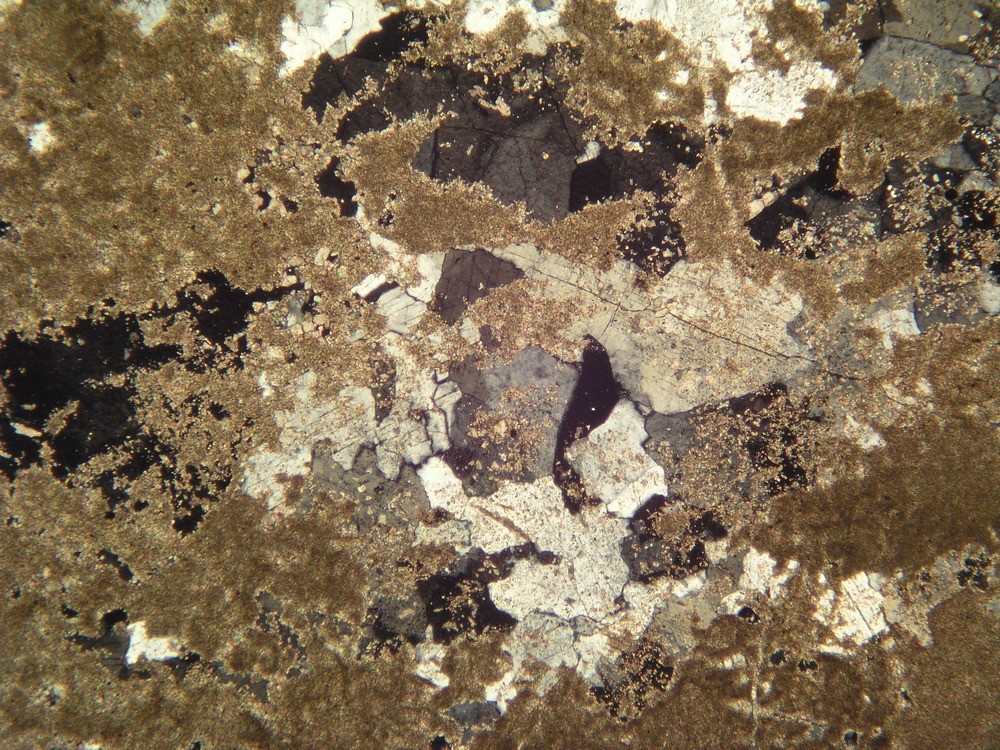| P number: | P552937 |
|---|---|
| Caption: | Limestone. Rhodes Quarry, 1 mile east of North Berwick. East Lothian. |
| Description: | A coarse grey limestone with calcite-filled fractures. Small aggregates of tarnished pyrite are present. The thin section shows turbid, finely divided calcite, extensively replaced by coarsely granular celestine and to a less extent by clear granular calcite. Where the original rock is preserved it seems to have been a calcite-mudstone containing small pellets. The white veins in the rock are calcite. The celestine is recognized by its similarity to baryte in its optical properties and by imparting a crimson-coloured flame to the bunsen. The rock contains 25 per cent of matter which is insoluble in cold dilute HCl and practically all of this is celestine. There is also some possibly carbonaceous matter and a very little quartz and chalcedony. The celestine fragments have a blue tinge without appreciable change in absorption on rotation in polarized light. Limestone, micrograined, extensively replaced by celestine. The rock from 6 ft. above the base (S 35151) consists of an extremely fine aggregate of calcite dolomitized along irregular channels which are frequently expanded into spaces the centres of which are either empty or filled with kaolin. There are also large cracks which are filled by calcite and celestine. Celestine sometimes is in idiomorphic tables or blades surrounded by calcite, sometimes forms bladed aggregates filling the vein. Less regular bodies of celestine and calcite enclose small pieces of the calcilutite bordered by dolomite and appear to be replacements, though doubtless connected with the veins. The rock from 11 ft. above the base (S 35152) is a turbid calcilutite containing fragments of very fine-grained rock of the same type. The matrix is patchily recrystallized and is permeated by a considerable quantity of celestine which seems to have replaced the recrystallized calcite and now encloses the turbid calcite. (d) As (b); 14 ft. from base. Lab. No. M27110; SrS04, 14.03%. The rock (S 35153) consists of a brown pelitomorphic aggregate of carbonate which develops perfect rhombic shapes against the numerous cavities and later fillings. Many of the cavities are filled by coarsely crystalline clear calcite and tables of celestine. The latter is always idiomorphic and presents sharp domal as well as basal faces to the calcite. Where calcite is absent the celestine moulds itself on the carbonate aggregate and develops good faces in the cavities. These coarsely crystalline minerals enclose spots of the brown carbonate aggregate which suggests that they are not only filling cavities but also replacing the pelitomorphic carbonate. SL0199. Britrocks S35064. Magnification x40. Light XPL. |
| Date taken: | Wed Jan 21 00:00:00 GMT 2004 |
| Photographer: | Sutherland, A. |
| Copyright statement: | NERC |
| Additional information: | Description from: Limestones of Scotland: chemical analyses and petrography. Edinburgh : HMSO, 1956. |
| Orientation: | Landscape |
| Size: | 390.72 KB; 1000 x 750 pixels; 85 x 64 mm (print at 300 DPI); 265 x 198 mm (screen at 96 DPI); |
| Average Rating: | Not yet rated |
| Categories: | Unsorted Images |
Reviews
There is currently no feedback

